In this Article:

In this article, we’ll explore two rifle cartridges: the .300 Winchester Magnum and the .300 Winchester Short Magnum. Despite their similar names, these cartridges differ significantly and offer some intriguing performance traits. We’ll examine a comprehensive set of data in this detailed comparison.
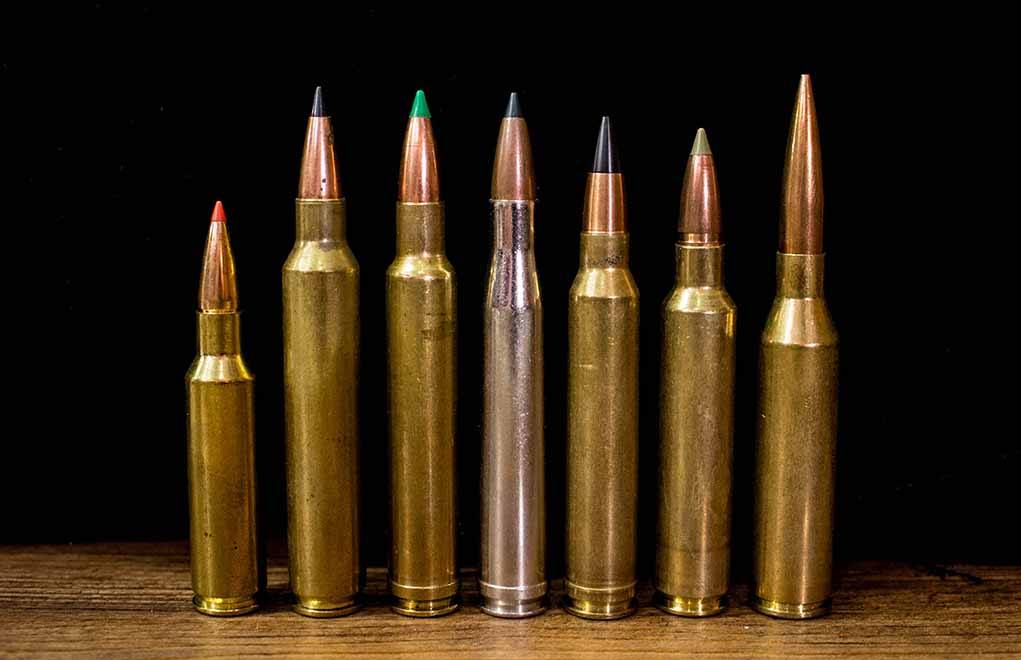
The similarity in their names can be misleading for those unfamiliar with these cartridges. Both can be used for similar shooting and hunting applications, but they are not interchangeable. Here, we’ll highlight the differences and the similarities between the .300 Win Mag vs .300 WSM. We are not looking to crown one cartridge as superior to the other. Instead, we want to present an unbiased view of these two cartridges. This will help you make a more informed choice about which cartridge best meets your shooting needs.
We’ll start by examining some ballistics data. Next, we’ll delve into the performance aspects of these cartridges. At the conclusion of the article, we will aim to synthesize this information and discuss which cartridge is most appropriate for specific purposes.
.300 Win Mag and .300 WSM Comparison Summary
| Test | .300 Win Mag | .300 WSM |
|---|---|---|
| Average Recoil (ft.lb) | 27.6 | 25.43 |
| Average Supersonic Flight Limit (Yards) | 2774 | 2799.3 |
| Average Short Range Bullet Drop at 100 yards | 0 | 0 |
| Average Ballistic Coefficient | 0.486 | 0.483 |
| Average Long Range Bullet Drop at 100 yards | 1.55 | 1.39 |
| Average Supersonic Flight Limit (Yards) | 1255 | 1286 |
| Average Kinetic Energy (fl. lb) at 100 yards | 3029.8 | 3114 |
| Average Sectional Density | 0.284 | 0.273 |
| Average Bullet Momentum (lb. f/s) at 100 yards | 71.2 | 70.3 |
A Brief History
.300 Winchester Magnum
The .300 Win Mag, like the .300 WSM, uses a 30-caliber bullet. Winchester introduced this cartridge in 1963, making it relatively new compared to other well-known hunting cartridges, though it predates the .300 WSM. It stands out as one of the most renowned magnum cartridges globally for factory loads and was the pioneer in the magnum category, much like the 7mm Remington Magnum, which debuted a year earlier. Nevertheless, the .300 WM seemed to come out at the right time.
The .300 Win Mag allows for a significant amount of powder, giving it a notable advantage in terms of velocity. It also accommodates a range of bullet weights, typically between 150 and 200 grains, though lighter and heavier options are available.
This cartridge is favored by long-range shooters, including big game hunters and competitive marksmen. It is also utilized by snipers in special forces and military units, though its primary use remains in hunting. Effectiveness often hinges on selecting the right ammunition for the specific hunting scenario.
.300 Winchester Short Magnum
Introduced to the public by Winchester in 2001, the .300 Winchester Short Magnum (WSM) quickly made waves in the hunting and shooting communities. Designed to deliver both power and speed while accommodating lighter rifles, the .300 WSM aimed to combine the performance of the .300 WM with the benefits of a shorter action.
The .300 WSM allows shooters to enjoy the power of the .300 WM but with the advantage of a lighter, short-action rifle. Short magnums, featuring a wider powder column, are intended to burn more evenly and cleanly. This is theoretically supposed to enhance accuracy, although the practical significance of this is open to debate and isn’t the focus of this article.
As one of the most popular short magnum cartridges to emerge in the past twenty years, the .300 WSM is versatile enough for both big game hunting and benchrest shooting. Its bullets range from 125 to 200 grains, with many experts agreeing that the 150-180 grain bullets are often the most effective for this cartridge.
Specs
| .300 Win Mag | .300 WSM | |
|---|---|---|
| Parent Casing | .375 H&H Magnum | - |
| Bullet Diameter | 0.308†| 0.308†|
| Neck Diameter | 0.339†| 0.344†|
| Base Diameter | 0.532†| 0.555†|
| Case Length | 2.62†| 2.1†|
| Overall Length | 3.34†| 2.86†|
| Case Capacity | 93.8gr | 80gr |
| Max Pressure (SAAMI) | 64,000psi | 65,000psi |
By examining the bullet and casing specifications of these two cartridges, we can start to infer their performance differences. This comparison also provides a reference point for interpreting the numerical data we’ll discuss later.
Both cartridges use a 30 cal bullet (.308â€), but their similarities largely end there. The .300 WSM features a slightly wider neck and base compared to the .300 WM. Conversely, the .300 WM has a case length and overall length that are each half an inch longer than those of the .300 WSM. This length difference in the .300 WM exceeds the width difference of the .300 WSM case. The variation in bullet seating depth within the casing is minimal and doesn’t significantly impact the case capacity, though the .300 Win Mag can hold slightly more powder. The .300 Win Mag also has a marginally lower maximum pressure.
Keep these details in mind as we compare actual data for these cartridges. We’ve selected ten rounds for this analysis, with five rounds for each cartridge. While more options are available, ten rounds offer a manageable range that avoids excessive complexity. Our selection includes various bullet types and weights, and the ten rounds graphed for this article are listed below.
Ammunition for Testing
 .300 Win Mag Federal Vital-Shok Trophy Bonded 180gr
.300 Win Mag Federal Vital-Shok Trophy Bonded 180gr .300 Win Mag Federal MatchKing BTHP Gold Medal 190gr
.300 Win Mag Federal MatchKing BTHP Gold Medal 190gr .300 Win Mag Barnes Precision Match OTM 220gr
.300 Win Mag Barnes Precision Match OTM 220gr .300 Win Mag Nosler Trophy Grade AccuBond Long Range 190gr
.300 Win Mag Nosler Trophy Grade AccuBond Long Range 190gr .300 Win Mag Hornady Superformance SST 180gr
.300 Win Mag Hornady Superformance SST 180gr
 .300 WSM Barnes VOR-TX TTSX Boat Tail 165gr
.300 WSM Barnes VOR-TX TTSX Boat Tail 165gr .300 WSM Hornady ELD-X Precision Hunter 200gr
.300 WSM Hornady ELD-X Precision Hunter 200gr .300 WSM Federal Edge TLR 200gr
.300 WSM Federal Edge TLR 200gr .300 WSM Federal Vital-Shok Trophy Bonded Tip 165gr
.300 WSM Federal Vital-Shok Trophy Bonded Tip 165gr .300 WSM Winchester Expedition Big Game 180gr
.300 WSM Winchester Expedition Big Game 180gr
If you already use one of these cartridge types, you might wonder why your preferred round isn’t included in this comparison. Rest assured, this is not an oversight, nor are we claiming these are the best rounds available. If your choice works well for you, that’s what truly matters.
To enhance our analysis, we’ve included data from an additional 15 rounds for each cartridge, bringing the total to 40 rounds. After evaluating various performance and ballistic factors, we compiled a table showing the averages for these rounds. This expanded dataset aims to provide you with more comprehensive information and assist in your decision-making process or deepen your understanding of a cartridge you favor.
The Samples
All the rounds selected for this comparison are factory loads and readily available. Factory loads typically use conservative powder charges to ensure safety. It’s important to note that all data presented here is computer-generated. We sourced the majority of the data from the manufacturer. For unavailable data, we relied on ballistic calculators from trusted sources. Additionally, we used ballistic calculators and kept as many variables the same between rounds of the same cartridge. We also made sure to clear our variables.
When comparing cartridges using this type of data, it’s worth noting that actual performance may vary when fired from your specific rifle. Each rifle has unique characteristics, which can lead to minor variations in ballistic output. However, computer-generated data helps eliminate these small differences and many environmental factors, making it useful for comparative purposes.
So, with all of that out of the way, let’s jump into our comparisons.
Recoil
Examining the recoil of the .300 Win Mag versus the .300 WSM is crucial for understanding why you might prefer one cartridge over the other in different scenarios. Recoil can be a significant factor, especially for younger or less experienced shooters, but even seasoned marksmen should consider it. Recoil affects shot accuracy, particularly in situations where you have limited time to prepare and can also impact your ability to take follow-up shots.
We will assess the energy produced when firing these rounds, which should not be confused with the “kick” felt during shooting. While this energy does contribute to felt recoil, it is a quantifiable measure. Felt recoil involves numerous additional factors that are challenging to quantify precisely.
Recoil Data
We used a ballistic calculator to generate the recoil energy generated from firing these ten rounds (Graph 1).
Due to the unavailability of specific propellant load data from the manufacturer, we used conservative estimates based on Nosler load data and kept the charge consistent for each round within a cartridge.
We should also note that we used the same gun weight for all ten rounds. In reality, most rifles chambered for the .300 WSM are often a little lighter with them having a short action. And by lighter, it’s usually around half a pound to a pound difference in weight. Lighter rifles generally produce a bit more recoil energy, so the actual recoil for .300 WSM rounds might be somewhat higher than our calculations suggest.
Looking at the graph, you’ll see that all ten rounds produce substantial recoil, exceeding 24 ft-lbs of energy. The .300 Win Mag rounds generate over 26 ft-lbs, with several reaching between 29 and 32 ft-lbs. In comparison, the .300 WSM rounds are close, ranging from 24 to 26 ft-lbs.
Generally, recoil over 20 ft-lbs can affect shot placement, though this is subjective and depends on the shooter’s experience. Inexperienced shooters may find both cartridges noticeable, potentially leading to flinching.
Below we have listed the average recoil energy from all forty rounds we have compiled.
Average Recoil (ft.lb)
| .300 Win Mag | .300 WSM |
|---|---|
| 27.6 | 25.43 |
Incorporating the additional rounds confirms the general trend: the .300 Win Mag has higher recoil energy compared to the .300 WSM. However, with the extra data, the difference between the two cartridges is narrower, showing just over a 2 ft-lb variance in average recoil energy.
Both cartridges generate substantial recoil. It’s worth noting that this difference could be even smaller if the .300 WSM rounds were tested with a slightly lighter rifle, as the lighter rifle would typically produce more recoil.
Ballistics
When comparing cartridges, analyzing their ballistics is crucial. Understanding how each round performs helps determine its suitability for various situations. In this section, we will examine the velocity, trajectory, and ballistic coefficients of the .300 Win Mag and .30-06 to gather the necessary data and draw conclusions about which cartridge may be more effective.
Both cartridges are .30 caliber, so it might seem that their ballistic performances are quite similar. However, there are significant differences between them, making it essential to closely examine various ballistic aspects.
It’s also important to remember that while we are evaluating these categories individually, this provides only part of the overall picture. All aspects, including those beyond ballistics, are interconnected and influence each other. We will integrate this information and discuss its practical implications in the application section.
Velocity
Velocity is a crucial characteristic of bullets for several reasons. A higher velocity means reduced impact from wind drift and gravity on the bullet’s trajectory, which is especially important for long-range shooting, a common use for these cartridges. As a bullet slows, external factors can significantly affect its accuracy.
Velocity also plays a key role in stopping power. Hunting bullets are designed to expand upon impact, creating more severe wounds and transferring optimal force to the surrounding tissue. To achieve the desired terminal ballistics, these bullets need to maintain sufficient speed.
Whether you’re hunting or engaging in bench rest shooting, understanding velocity is essential when choosing between cartridges. It affects nearly every performance metric discussed in cartridge comparisons.
We have compiled the velocity data for all ten rounds from the muzzle out to 500 yards and graphed them here (Graph 2).
Bullet Velocity Data
Several conclusions can be drawn from the velocity data.
First, both cartridges exhibit high velocities, averaging nearly 3,000 fps. At 500 yards, all rounds remain supersonic, with speeds exceeding 2,000 fps. Within the first 200 yards, the .300 WSM shows a slight edge, with a velocity difference of less than 100 fps compared to the .300 Win Mag. From 300 to 500 yards, the .300 Win Mag gains a slight advantage, though again, the difference is under 100 fps. Overall, their performance is quite similar across various ranges.
Below are the average velocities for all forty rounds we analyzed. Even with the expanded sample size, the general trend persists, indicating that these two cartridges have closely matched bullet velocities. The additional rounds reveal that the .300 WSM maintains its slight advantage over the .300 Win Mag beyond the 200-yard mark.
With average velocities within 100 fps of each other, there is considerable overlap in performance between these factory loads. Both cartridges are suitable for long-range shooting applications. For hunters, the rounds remain supersonic, as indicated by the velocity data.
When bullets drop below supersonic speeds, their flight stability decreases and they become more influenced by environmental factors. Being aware of this helps in making precise calculations for shot placement.
Average Supersonic Flight Limit (Yards)
| .300 Winchester Magnum | .300 Winchester Short Magnum |
|---|---|
| 1255 | 1286 |
Both cartridges stay in supersonic flight beyond the 1,200-yard mark. On average, the .300 WSM maintains supersonic speeds slightly longer than the .300 Win Mag, by about thirty yards. Examining individual rounds (data not shown) reveals that rounds from both cartridges are thoroughly mixed. For those seeking rounds that remain supersonic, both the .300 Win Mag and the .300 WSM offer numerous viable options.
Ballistic Coefficient (BC)
The ballistic coefficient (BC) is crucial when evaluating cartridges designed for larger game and for long-range shooting, where wind effects become more significant. This is particularly relevant for the .300 Win Mag and .300 WSM cartridges.
In simple terms, the ballistic coefficient is a value calculated from various bullet flight specifications. A higher BC indicates that the bullet is less affected by wind resistance and drag. Ideally, a bullet with a higher BC should offer better accuracy, as it remains more stable and on target after being fired.
If you’re only shooting within 200 yards, the differences in BC might be minor. However, for those planning longer shots, BC becomes an important factor to consider.
We have compiled the BC data for each of the ten rounds and presented it in the following graph (Graph 3).
In the graph, the rounds from both cartridges exhibit high ballistic coefficients, with some showing excellent performance. On average, the .300 Win Mag rounds have a slightly higher BC of 0.553, compared to 0.520 for the .300 WSM. However, averages don’t represent all individual rounds. For instance, the .300 WSM includes two rounds with BCs of 0.45 and below, while the .300 Win Mag has only one round with a BC below 0.50. Both cartridges offer options with BCs exceeding 0.60, which are particularly appealing for long-range shooting.
This analysis covers just five rounds from each cartridge. We acknowledge that not all available rounds will fall within these ranges. Typically, factory loads will hover around these numbers, but high BC options are available for both cartridges if needed.
To gain a more comprehensive understanding of how these cartridges compare, let’s review the averages from our larger sample set.
Average Ballistic Coefficient
| .300 Winchester Magnum | .300 Winchester Short Magnum |
|---|---|
| 0.486 | 0.483 |
A notable observation is that the ballistic coefficients (BCs) for both cartridges decrease significantly compared to the smaller sample set. Despite this drop, the average BCs for both cartridges remain quite respectable. The difference in BCs between the two is not substantial enough to suggest a clear advantage for either cartridge. Both cartridges feature high BCs and include options at the lower end of the scale.
Trajectory
Trajectory is a key ballistic property frequently discussed when comparing the performance of different rounds or cartridges. Trajectory refers to the elevation of a bullet as it travels downrange, specifically how much it drops over distance. A bullet follows an arcing path, gradually descending in elevation. Factors influencing trajectory include bullet specifications, environmental conditions, velocity, ballistic coefficient (BC), gravity, and wind resistance.
Hunters and marksmen generally prefer a flatter trajectory, which means less pronounced drop over distance. A flatter trajectory simplifies adjustments for long-range shots and provides more margin for error when estimating a target’s range.
Given the complexity of trajectory analysis with ten different rounds, each varying in powder charge and bullet weight, the discussion can become quite intricate. Therefore, we decided to simplify by comparing two similar rounds—one from each cartridge—manufactured by the same company, featuring the same bullet design, weight, and similar BCs.
Examining Graph 4, it’s challenging to distinguish two separate trajectories. This suggests that, based on the basic design, the differences between these two cartridges do not significantly impact bullet drop. Instead, factors such as bullet design, weight, and powder charge play a crucial role in determining each round’s trajectory. Variations in cartridge specifications and commonly used bullet types and weights also influence the results.
Both rounds exhibit a bullet drop of approximately 45 inches at 500 yards, which is reasonable for factory loads intended for hunting rather than extreme long-range shooting. To gain a clearer understanding, let’s examine how our ten rounds compare in terms of trajectory.
Short Range Trajectory
While the .300 Win Mag and .300 WSM are often associated with long-range shooting, many hunters will take shots within 300 yards. Therefore, it’s important to examine the trajectories of these rounds when the rifle is zeroed at 100 yards (see Graph 5).
Short Range Trajectory Data
In this set of data, there is no distinct pattern indicating that rounds from one cartridge consistently group together. This trend is likely to persist even with a larger sample size. At the 200-yard mark, the average bullet drop between the two cartridges shows a minimal difference of just 0.14 inches, with the .300 Win Mag having a slight advantage. The flattest .300 Win Mag round has a bullet drop of 2.2 inches, while the flattest .300 WSM round drops 2.6 inches.
At the 300-yard mark, the rounds remain interspersed, but the difference between the average bullet drops becomes more noticeable. The .300 Win Mag averages a bullet drop of 9.9 inches, compared to 11.06 inches for the .300 WSM—still less than two inches apart. This difference is partly influenced by the .300 Win Mag Trophy Bonded ammo from Federal, which shows a superior bullet drop of just 6.6 inches, outperforming other rounds from both cartridges. However, there are .300 WSM rounds available that can offer comparable performance.
For the remaining rounds at 300 yards, the trajectory differences between the two cartridges are negligible. Both cartridges have rounds with varying degrees of drop, but the steepest drop is just over 12 inches at 300 yards, a manageable range with modern rifle optics and experience.
The observed trend persists even with additional cartridges, and a 400-yard marker has been included for further comparison.
Average Bullet Drop (Inches) at Short Range
| Yards | .300 Win Mag | .300 WSM |
|---|---|---|
| 50 | -0.234 | -0.235 |
| 100 | 0 | 0 |
| 200 | -2.88 | -2.9 |
| 300 | -11.12 | -11.4 |
| 400 | -25.6 | -24.9 |
From the perspective of computer-generated data, there is little distinction between the two cartridges in terms of short-range trajectory. The averages show that the .300 Win Mag has approximately half an inch less bullet drop at 300 yards. However, the distribution of individual rounds from both cartridges is so similar that they effectively appear to perform similarly in this regard.
At the 400-yard mark, the .300 WSM rounds average a bullet drop of about 0.7 inches more than the .300 Win Mag. Based on this data, both cartridges offer options for relatively flat shooting. Trajectory differences are minimal and likely won’t be the primary factor in choosing between them until you decide which specific round best suits your rifle and shooting needs.
Long Range Trajectory
Many people are particularly interested in how these cartridges perform at longer ranges. Therefore, we have compiled and presented the long-range data for both cartridges here (see Graph 6).
Long Range Trajectory Data
We measure the bullet drop (inches) out to 700 yards with the rifle zeroed in at 200 yards.
Examining Graph 6, several key observations emerge. Initially, all ten rounds group tightly up to 500 yards. At 600 and 700 yards, gaps start to appear between the rounds, but, similar to the short-range data, there is no clear pattern in how rounds from each cartridge cluster. Impressively, all rounds exhibit less than 110 inches of bullet drop at 700 yards, which is commendable for factory loads primarily intended for hunting.
Throughout the range, the difference between the averages of the two cartridges remains within an inch. Individual rounds show variability, with some rounds from both cartridges exhibiting flatter or steeper trajectories. Notably, the flattest and steepest shooting rounds include examples from both the .300 Win Mag and .300 WSM.
Keep in mind that the data presented here is based on factory loads. Hand loading can significantly enhance the performance specifications of both cartridges.
For further analysis, we have included a table listing the averages for all forty rounds and their long-range trajectory numbers, with a 1,000-yard mark for additional comparison.
Average Bullet Drop (Inches) at Long Range
| Yards | .300 Win Mag | .300 WSM |
|---|---|---|
| 100 | 1.55 | 1.39 |
| 200 | 0 | 0 |
| 300 | -6.8 | -6.3 |
| 500 | -39.45 | -38.8 |
| 700 | -102.5 | -101.9 |
| 1000 | -295.6 | -285.8 |
At the 1,000-yard mark, there is a slight increase in the separation between the two cartridges in terms of bullet drop. However, this difference remains under 10 inches. Notably, several .300 Win Mag rounds demonstrate trajectory performance equal to or better than the top-performing .300 WSM rounds.
The .300 Win Mag includes several rounds with bullet weights exceeding 190 grains, which affects its trajectory at long distances. These heavier rounds tend to have more significant bullet drop, which is a typical tradeoff with high-weight ammunition. Despite this, they may offer better performance in other aspects.
For hunting purposes, where effectiveness on big and thick-hided game is crucial, the ballistic data is important, but the stopping power of the cartridges is paramount. With that in mind, let’s delve into the stopping power of these cartridges.
Stopping Power
While both cartridges are utilized in bench shooting, their primary appeal is for big game hunting, which demands significant stopping power. This aspect is particularly relevant for hunters, though understanding these factors can benefit any shooter.
Estimating stopping power is a topic of considerable debate. Some experts prioritize kinetic energy, others focus on momentum, and some believe these metrics are insufficient. We contend that all these factors contribute to assessing stopping power. Although we will examine kinetic energy and sectional density separately, they should be considered collectively when choosing the more suitable cartridge for specific applications.
Other factors, such as bullet design and expansion characteristics, also play crucial roles in determining a bullet’s effectiveness in taking down game. While we cannot quantify these aspects in our comparison, our focus will remain on the energy transfer and potential penetration capabilities of each cartridge.
Kinetic Energy
Every bullet, upon firing, carries kinetic energy generated by the ignition of the gunpowder and the bullet’s weight—a basic principle of physics. Upon impact, this kinetic energy is transferred to the target, causing damage to tissues and organs.
For large game, a general rule is to aim for a minimum of 1,000 ft.lbs of energy, with some experts recommending 1,500+ ft.lbs for animals like bears, elk, and moose. While understanding the kinetic energy of a bullet is important for hunting, these guidelines are not absolute. Shot placement often plays a more critical role than sheer energy.
This sub-category is going to cater more towards those looking for a hunting cartridge, but if you’re going to buy a rifle chambered for one of these cartridges, then there is no harm in understanding as much as you can about each.
And given that we are dealing with two cartridges that are known for their incredible knockdown power, this is an important section if your choice is coming down to these two cartridges.
We compiled the energy data from the manufacturers of these ten rounds and graphed them below (Graph 7).
Kinetic Energy Data
As noted with other categories, there are significant similarities between the .300 Win Mag and .300 WSM cartridges. However, we observe a more noticeable difference in the average kinetic energy of these two cartridges.
Examining the averages alone, the .300 Win Mag exhibits an edge of approximately 50-100 ft.lbs over the .300 WSM from the muzzle up to 500 yards. While performance varies among individual rounds, both cartridges provide powerful energy across this distance. From the muzzle, all of these rounds show bullet energy levels greater than 3,400ft.lb with two of the Win Mag rounds showing greater than 3,700ft.lb of energy. With these two cartridges, we are more interested in the energy once we get out to the 100-300 yard range and beyond.
At these ranges, all ten rounds still carry more than 3,000ft.lb of kinetic energy, and all of them maintain this energy fairly well as they move to 200 yards where they all still have well over 2,500ft.lb of energy. From the muzzle out to 200 yards, all of the rounds group pretty tightly together but we do see the two .300 Win Mag rounds show slightly higher energy than the other eight rounds. From 300 to 500 yards, the difference shrinks between those two rounds and the other eight.
At 300 yards, all these rounds still have well above 2,000 ft. lbs. Several rounds, including both .300 Win Mag and .300 WSM, still, carrying more than 2,500ft. lb.
At 400 and 500 yards, we start to see the rounds begin to separate from each other. All of them still carry a tremendous amount of energy at these extreme ranges when it comes to hunting though with all of the rounds bringing more than 1,500ft.lb with two rounds still carrying over 2,000ft.lb, one .300 Win Mag and one .300 WSM.
Average Kinetic Energy (ft.lb)
| Yards | .300 Win Mag | .300 WSM |
|---|---|---|
| 0 | 3479.5 | 3580 |
| 100 | 3029.8 | 3114 |
| 200 | 2628 | 2673.4 |
| 300 | 2299.6 | 2336.7 |
| 400 | 1988.3 | 1989.7 |
| 500 | 1741.3 | 1736.7 |
Although the differences between the cartridges remain consistent, the kinetic energy advantage has shifted from the .300 Win Mag to the .300 WSM at the muzzle and 100 yards. This shift is one of the reasons we included a larger data set, to account for such variations.
Overall, there’s no substantial difference between the cartridges, with rounds from each cartridge showing a fairly even distribution if graphed. Given the kinetic energy formula and the velocity data from the muzzle to 100 yards, it makes sense that the .300 WSM rounds would exhibit a slight increase in kinetic energy at these distances.
Penetration (Sectional Density)
When hunting large game, ensuring that your round can penetrate thick skin and dense tissue to reach vital organs is crucial. One way to assess this capability is by comparing the sectional density (SD) of the bullets used.
The SD is derived from a calculation using the bullet’s diameter and weight. A bullet with a higher sectional density should have greater penetration than a bullet with a lower SD. The sectional density alone does not indicate penetration. The velocity as well as the design of the bullet factor in as well. Higher velocities increase penetration as does highly bonded bullets that will not fragment on impact.
It’s important to note that greater penetration isn’t always synonymous with a better cartridge. The effectiveness of penetration varies depending on the target. We’ll explore this further in the application section.
We’re not suggesting that sectional density is the only factor influencing penetration. It’s just one component of the broader picture of stopping power.
The sectional density calculations for the ten rounds are displayed in the graph below (Graph 8).
The sectional density numbers reveal that the differences between the two cartridges are relatively minor. Both the .300 Win Mag and the .300 WSM have several rounds falling within the .25 to .30 range. On average, the .300 Win Mag exhibits a slightly higher sectional density. This is expected, as the .300 Win Mag often uses heavier bullets compared to the .300 WSM, despite both cartridges firing .308†bullets.
In the table below, you will find the sectional density data from the larger data set.
Average Sectional Density
| .300 Winchester Magnum | .300 Winchester Short Magnum |
|---|---|
| 0.284 | 0.273 |
The data shows that the .300 Win Mag maintains a marginally higher sectional density compared to the .300 WSM rounds. As with many other comparisons, there is significant overlap between the rounds of both cartridges. Given that both cartridges use bullets of the same diameter, the difference essentially comes down to the bullet weights.
It’s important to remember that sectional density is just one component of the overall stopping power equation. Bullet momentum, which complements sectional density, is another critical factor influencing penetration. We’ll delve into momentum in the upcoming section.
Penetration (Momentum)
Momentum represents how much force is required to stop a moving object, so higher momentum means a bullet will continue moving with greater force, making it more effective at penetrating dense materials. This is particularly crucial for hunting larger game where the bullet needs to penetrate thick hide and bone. For self-defense scenarios, the required momentum might be less, as the conditions and targets differ. However, bullet design, sectional density, and expansion also affect penetration.
Sectional density impacts momentum since a bullet with higher sectional density will conserve more momentum when impacting a smaller area. This means a bullet with higher sectional density can penetrate deeper due to its ability to maintain momentum over a smaller resistance surface.
We have calculated the bullet momentum by using the bullet’s mass and velocity for each round and graphed them below (Graph 9).
As with other categories, the momentum data for these cartridges shows considerable overlap among the selected rounds. Both the .300 Win Mag and .300 WSM cartridges feature rounds that start with momentum in the 70-80 lb·ft/s range, with the .300 Win Mag rounds showing a slight edge in the averages. The average momentum for the .300 Win Mag is 80.0 lb·ft/s, compared to 77.12 lb·ft/s for the .300 WSM. This difference remains relatively consistent out to the 500-yard mark, where the average momentum for the .300 Win Mag is 58.2 lb·ft/s, while the .300 WSM averages 22.3 lb·ft/s.
Despite the slight advantage in the averages for the .300 Win Mag, several .300 WSM rounds match or exceed the bullet momentum of certain .300 Win Mag rounds.
In the table below, we have listed the average bullet momentum numbers over a 500-yard range for the forty compiled rounds.
Average Bullet Momentum (lb.f/s)
| Yards | .300 Win Mag | .300 WSM |
|---|---|---|
| 0 | 75.8 | 75.4 |
| 100 | 71.2 | 70.3 |
| 200 | 64.9 | 64.9 |
| 300 | 61.6 | 60.9 |
| 400 | 57.2 | 56.2 |
| 500 | 53.7 | 52.7 |
In examining the complete data set, the .300 Win Mag rounds continue to show a slight advantage over the .300 WSM rounds. However, the gap between the average values for the two cartridges has narrowed. While this difference is present, it is not substantial enough to be a decisive factor in comparing the cartridges. As with other categories, variability exists not only between the .300 Win Mag and .300 WSM rounds but also among rounds of the same cartridge type. This underscores the importance of considering specific round performance within each cartridge rather than relying solely on averages.
Accuracy
Anytime you bring up two cartridge types, the argument for accuracy eventually rears its ugly and opinionated head.
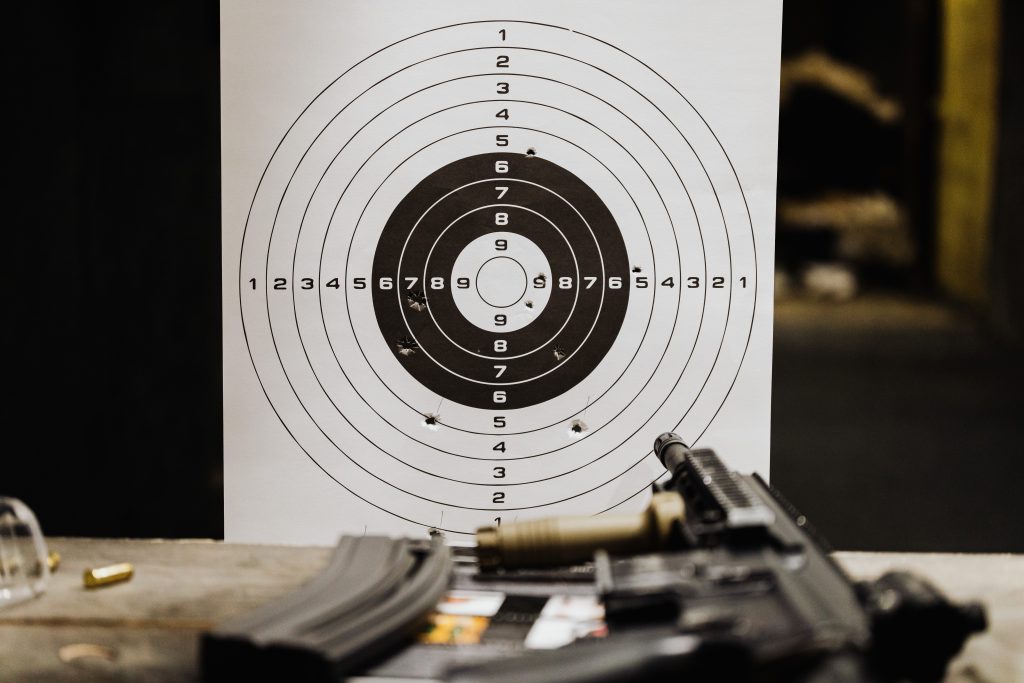
Accuracy is undeniably crucial; after all, there’s little value in a round that can’t hit its target. However, it’s important to recognize that the cartridge itself is just one piece of the accuracy puzzle. Equally significant is how well the ammunition cycles through your firearm—some ammo performs better with certain rifles than others. Additionally, the skill of the shooter plays a pivotal role in accuracy.
Measuring Minute of Angle (MOA) is a common way to assess the accuracy of rounds for individuals, but this method has limitations when comparing cartridges. MOA values can fluctuate daily due to environmental conditions and individual performance. Moreover, the rifle used for testing may yield different results compared to the one you use.
And we are not discounting that method of determining accuracy. We just don’t think it’s the best method for looking at two cartridges with a broad view and being able to present you with data that remains consistent.
We can look back at some of the other ballistic characteristics we have already examined. That performance can give us some indication of how difficult it might be to place the bullet in the vitals or the bullseye. And of course, this is not taking into account the rifle or the user.
Accuracy and Velocity
We didn’t see any huge difference in velocity from the averages of the cartridges out of the muzzle. Velocity, when paired with the correct barrel twist can make the bullet more stable. So your rifle is going to be a major factor in the velocity of these rounds being a pro or con. Still, a lot of people like high velocity and feel that their rounds perform better with a little extra speed. While the averages were slightly in favor for the .300 Win Mag (around 50 more fps), there were individual rounds, for both the .300 WM and .300 WSM that outperformed the other rounds in muzzle velocity.
Regarding trajectory, the differences between the cartridges were also minimal. Averaging the data, we found that the bullet drop never exceeded a one-inch difference at both short and long ranges. Among the ten rounds analyzed, the flattest trajectory was exhibited by a .300 Win Mag round, while the steepest drop was also from a .300 Win Mag round. Both cartridges displayed impressive trajectories for factory loads, averaging 6.64 inches at 300 yards, 19.2 inches at 400 yards, and 100.9 inches at 700 yards.
Other Factors Affecting Accuracy
In addition to trajectory, a bullet’s ability to resist drag and wind resistance is crucial for accuracy. Our analysis of the ballistic coefficients showed that the .300 Win Mag has a slight advantage in average BC compared to the .300 WSM. However, several .300 WSM rounds have BCs ranging from .5 to over .6, so neither cartridge has a definitive edge in this aspect. Typically, .300 Win Mag rounds are slightly heavier than those of the .300 WSM, primarily due to feeding issues associated with the shorter action of .300 WSM rifles. However, if the rifle functions well, there are high-BC .300 WSM options available that surpass the BCs of the lighter .300 Win Mag rounds.
Recoil energy is another area where we noticed differences. Both cartridges produce sufficient recoil to affect shooting accuracy, especially after extended periods or for less experienced shooters.
The .300 Win Mag generally has higher recoil energy, which, combined with the typically heavier rifles designed for it, can be more taxing. In contrast, .300 WSM rifles are lighter, which can result in a more noticeable recoil despite the generally lower recoil energy of the cartridges. While both cartridges produce significant recoil, with some practice and proper handling, most shooters will adapt and maintain accuracy despite the recoil differences.
Barrel Length
One final consideration is barrel length. As previously noted, the .300 WSM is often chambered in shorter, lighter rifles, which usually means a shorter barrel. There’s ongoing debate about whether longer barrels can enhance accuracy. While the relationship isn’t straightforward—such as a direct correlation where each additional inch of barrel length equates to tighter groupings—longer barrels can impact a bullet’s velocity and stability. This effect generally suggests that longer barrels could contribute to improved accuracy. Though our analysis of these ten rounds doesn’t directly address this factor, it’s worth exploring further if you’re considering how barrel length might influence your shooting performance.
Price & Availability
The ongoing ammo shortage is affecting the .300 as well. While you can find both the .300 Win Mag and the .300 WSM can in major retail stores, there are usually more options for the .300 Win Mag. It is an older round with a much larger following. In addition, the WSM and the manufacturers know this. It’s not that you can’t get what you want of the .300 WSM, but you might have to shop around more for it.
Regarding cost, the price of ammunition can differ depending on the specific round. On average, the .300 Win Mag might be a few dollars more expensive compared to the .300 WSM. However, many shooters prioritize performance over price. If a round meets your performance needs, the additional cost per box is often seen as justifiable. Both cartridges are pricier than many other centerfire options, but they offer significant advantages in terms of stopping power and ballistic performance.
| Ammunition | Price (20 Rounds) |
|---|---|
| .300 Win Mag Federal Vital-Shok Trophy Bonded 180gr | $54 |
| 300 Win Mag Federal MatchKing BTHP Gold Medal 190gr | $83 |
| .300 Win Mag Nosler Trophy Grade AccuBond Long Range 190gr | $74.20 |
| .300 Win Mag Barnes Precision Match OTM 220gr | $60.99 |
| .300 Win Mag Hornady Superformance SST 180gr | $49.47 |
| .300 WSM Winchester Expedition Big Game 180gr | $62 |
| .300 WSM Federal Vital-Shok Trophy Bonded Tip 165gr | $57.99 |
| .300 WSM Federal Edge TLR 200gr | $57 |
| .300 WSM Hornady ELD-X Precision Hunter 200gr | $53.99 |
| .300 WSM Barnes VOR-TX TTSX Boat Tail 165gr | $59.99 |
Applications
Examining these factory rounds reveals no significant difference in average velocity between the .300 Win Mag and the .300 WSM. The .300 Win Mag rounds show a slight edge, with about 40-50 fps more velocity at each distance marker. The impact of this extra velocity on accuracy isn’t fully clear in this context, but higher velocity can be beneficial for long-range shooting. Both cartridges offer high-velocity options, which some shooters prefer.
However, increased velocity also means more recoil. Most shooters find this manageable, especially given the benefits in stopping power and trajectory. Both cartridges are suitable for long-range shooting and offer impressive factory load trajectories. While handloads can provide flatter shooting, these factory rounds perform well for both beginners and those transitioning to handloading. Additionally, both cartridges include options with high ballistic coefficients, which help with accuracy in windy conditions and at distances over 500 yards.
These features are also valuable for hunting large game, where shots beyond 300 yards are common. Both cartridges maintain over 2,000 ft.lb of energy at 300 yards, with several rounds exceeding 2,500 ft.lb. Even at 400 yards, the energy remains around 2,000 ft.lb, which is adequate for big North American game. While bullet energy isn’t the sole factor in stopping power, it is crucial, and these numbers should provide confidence in your shooting performance.
Big Game Hunting
When hunting large game, the .300 Win Mag offers an advantage in terms of bullet size. The larger, heavier bullets provide increased penetration and stopping power, which is beneficial for taking down big game. Although there are .300 WSM rounds available with 200-grain bullets, some shooters report issues with feeding these larger bullets through short-action rifles.
If your rifle can accommodate these heavier bullets, it shouldn’t pose a problem. While the .300 Win Mag shows slight advantages in sectional density and bullet momentum averages, the .300 WSM rounds are competitive and offer high performance in these areas as well. Based on the data provided, both cartridges are well-suited for achieving deep penetration and are capable of handling the demands of hunting large game.
Best Rounds
Top Hunting Round
From a hunting perspective, the .300 Win Mag Nosler Trophy Grade, AccuBond Long Range 190gr round stands out. This round is highly recommended for taking down large and even dangerous game. The AccuBond bullet design ensures deep penetration with controlled expansion, delivering substantial damage. Even at 500 yards, it retains 2,016 ft.lbs of energy, demonstrating excellent range and stopping power. Its trajectory remains remarkably flat out to 300 yards and is manageable at 400 yards, thanks to a ballistic coefficient of 0.64. This round combines all the essential characteristics for effective large game hunting.
For those seeking a top choice in big game hunting, the Hornady 200gr Precision Hunter is exceptional. Its bullet design offers controlled expansion for optimal penetration and kinetic energy transfer. This round also boasts significant momentum, crucial for taking down large, tough game. Its trajectory is impressively flat at both 300 and 500 yards, complemented by a ballistic coefficient of .597, which aids in handling challenging wind conditions in the field.
Looking for the best budget hunting rifles, check out our guide.
Top Range Round
For those shooting the .300 Win Mag, the Hornady Superformance SST 180gr is a standout option for the range. While it doesn’t have the highest ballistic coefficient compared to some other rounds, it is one of the more affordable .300 WM options we’ve reviewed. Notably, it offers impressive velocities and a remarkably flat trajectory, with less than 100 inches of bullet drop at 700 yards, which is exceptional for a factory load.
If you prefer shooting the .300 WSM, the Barnes VOR-TX TTSX 165gr is an excellent choice for the range. It produces slightly less recoil compared to other rounds but maintains one of the flattest trajectories among the .300 WSM options we’ve analyzed. Additionally, it delivers high muzzle velocity and, although its ballistic coefficient isn’t the highest, it is still quite good. Users report strong performance at long distances with this round.
Conclusion
After analyzing the data for the .300 Win Mag and .300 WSM rounds, it’s clear that there isn’t a significant difference between the two cartridges in terms of overall performance. Variations do exist among individual rounds, but it’s challenging to definitively state which cartridge consistently outperforms the other in every ballistic aspect.
The primary distinction between these cartridges lies not in their ballistic performance, but in the rifle platforms they are used with. While understanding the similarities and differences between cartridges is important, the choice between the .300 Win Mag and .300 WSM often comes down to other considerations, such as rifle design and personal preference.
Ultimately, from a ballistic and performance perspective, the decision between these two cartridges is largely a matter of personal choice. Whether you’re engaging in long-range shooting or hunting large game like a bull moose, both cartridges, when used effectively, will serve you well and contribute to a successful hunt.
Ammunition List
| Ammunition | Price (20 Rounds) |
|---|---|
| .300 Win Mag Federal Vital-Shok Trophy Bonded 180gr | $54 |
| 300 Win Mag Federal MatchKing BTHP Gold Medal 190gr | $83 |
| .300 Win Mag Nosler Trophy Grade AccuBond Long Range 190gr | $74.20 |
| .300 Win Mag Barnes Precision Match OTM 220gr | $60.99 |
| .300 Win Mag Hornady Superformance SST 180gr | $49.47 |
| .300 WSM Winchester Expedition Big Game 180gr | $62 |
| .300 WSM Federal Vital-Shok Trophy Bonded Tip 165gr | $57.99 |
| .300 WSM Federal Edge TLR 200gr | $57 |
| .300 WSM Hornady ELD-X Precision Hunter 200gr | $53.99 |
| .300 WSM Barnes VOR-TX TTSX Boat Tail 165gr | $59.99 |

More .300 articles:
- .300 Winchester Magnum: A Brief Guide
- .300 Win Mag vs .308 Win – Cartridge Comparison
- .300 Win Mag vs .30-06 Sprg – Cartridge Comparison
- .300 Blackout vs .308 Win – Cartridge Comparison
- Best Concealed Carry Insurance
- Beginner Firearm Safety, From Safe Storage to Safe Shooting
Updated August 2024

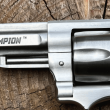



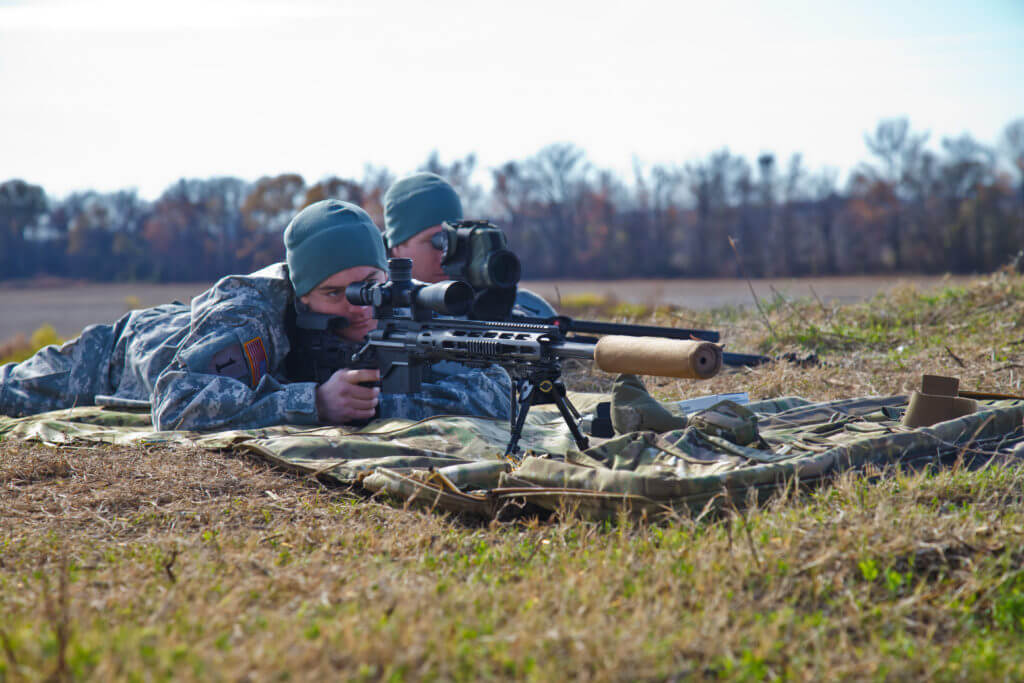
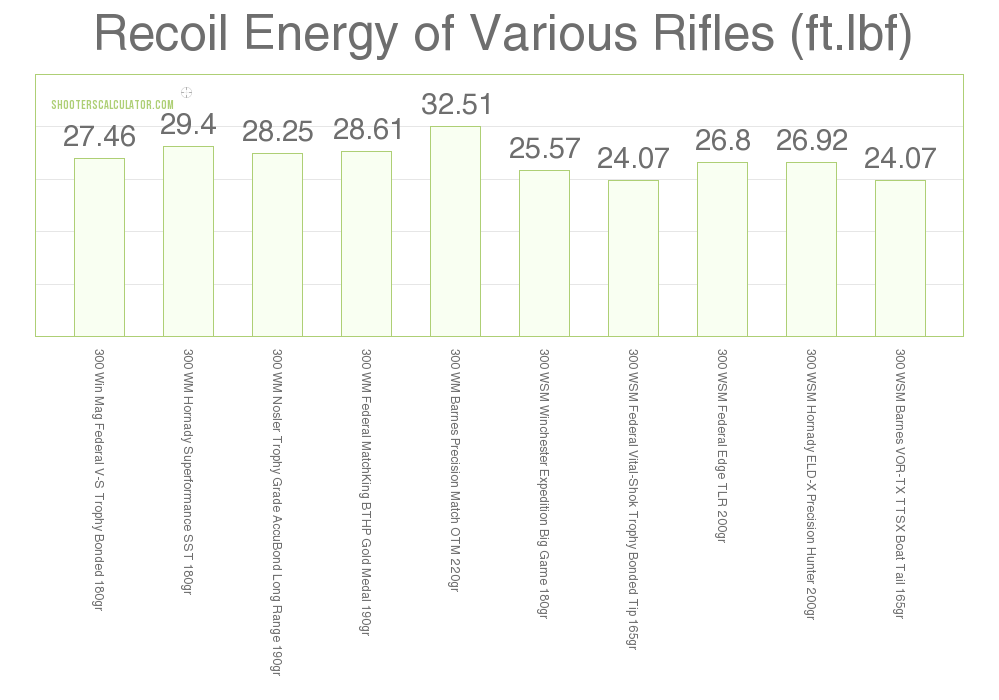
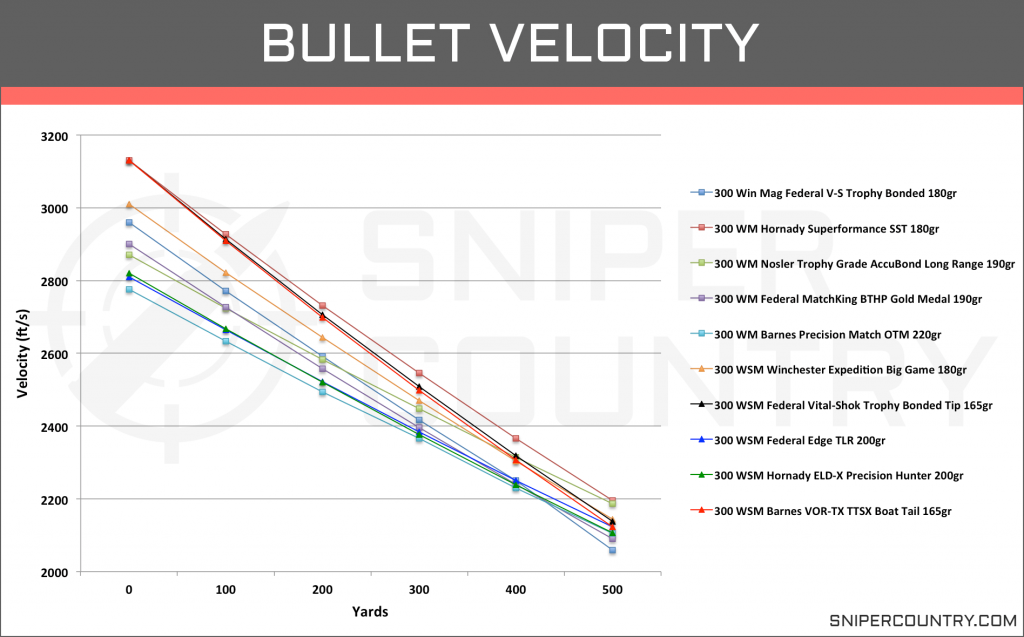
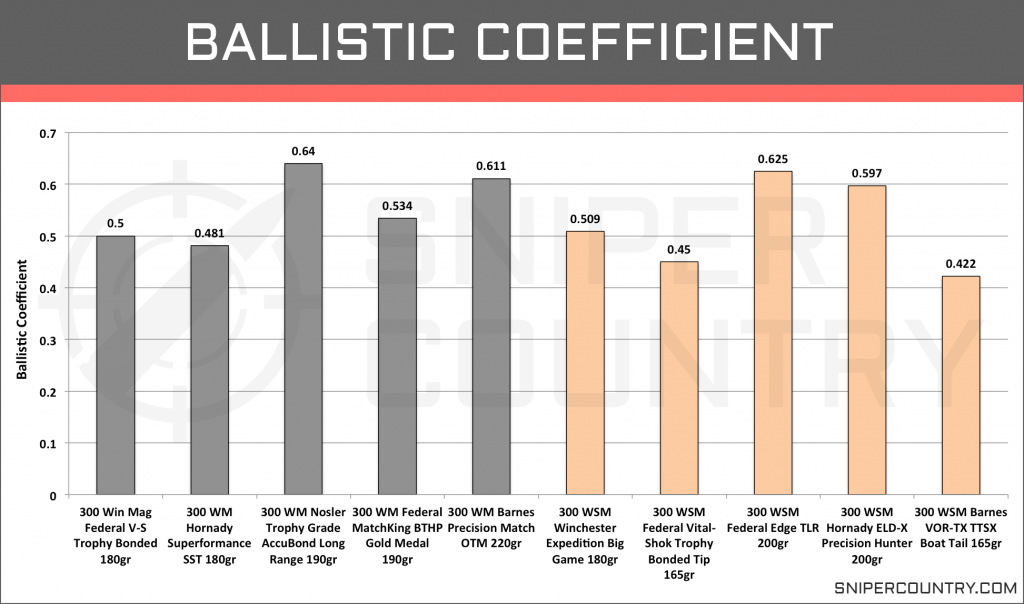
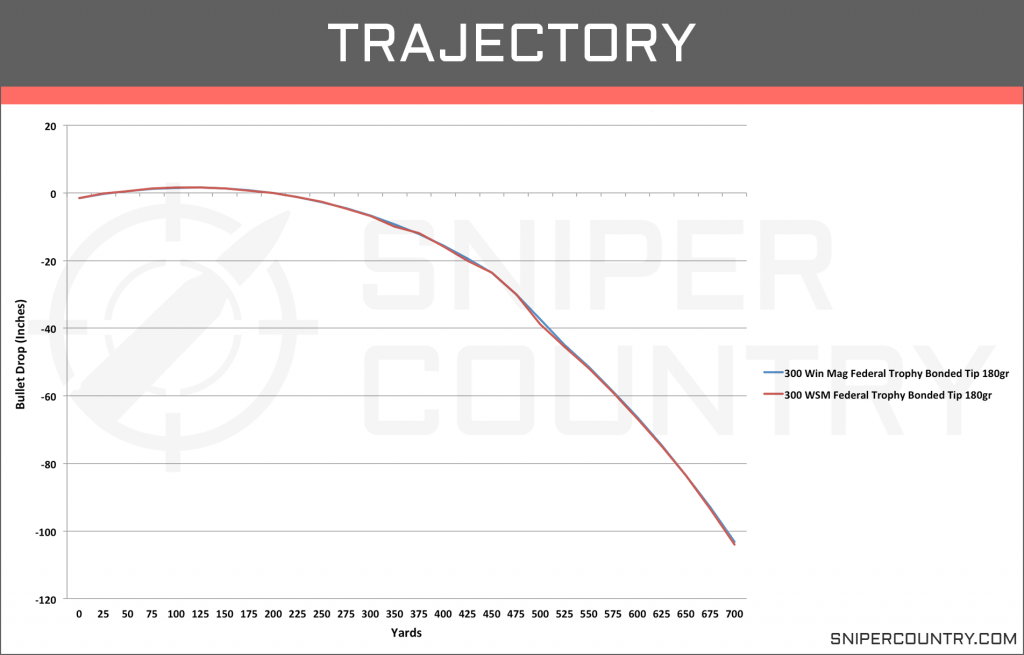
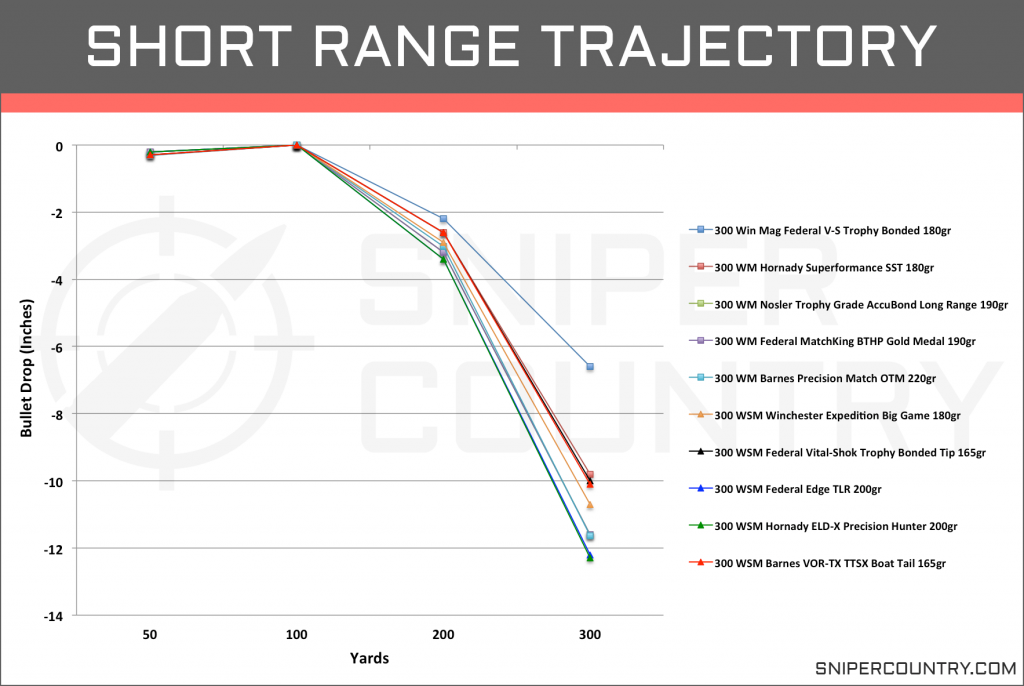
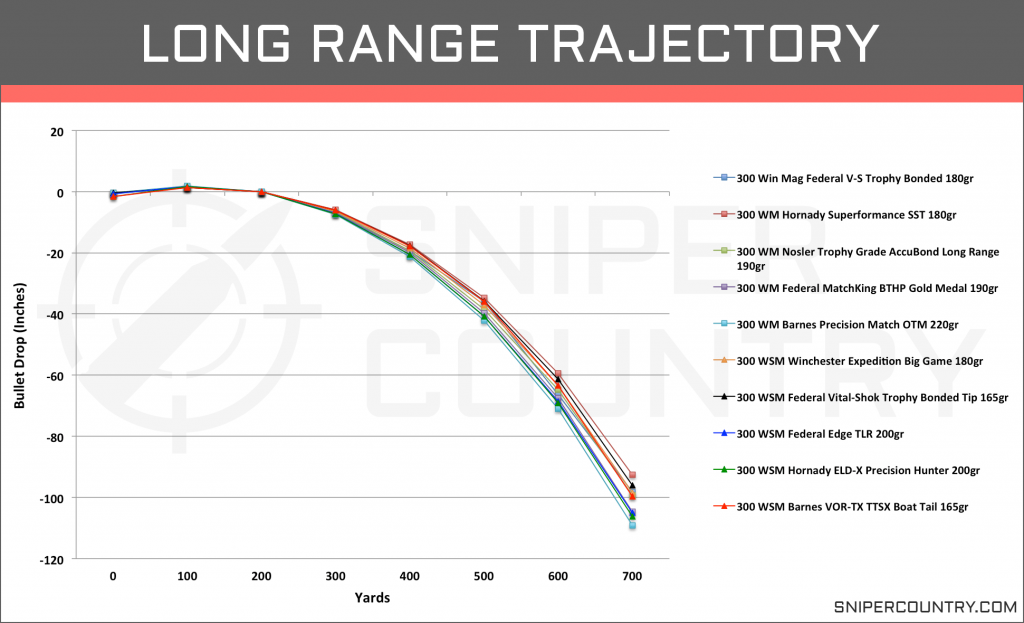
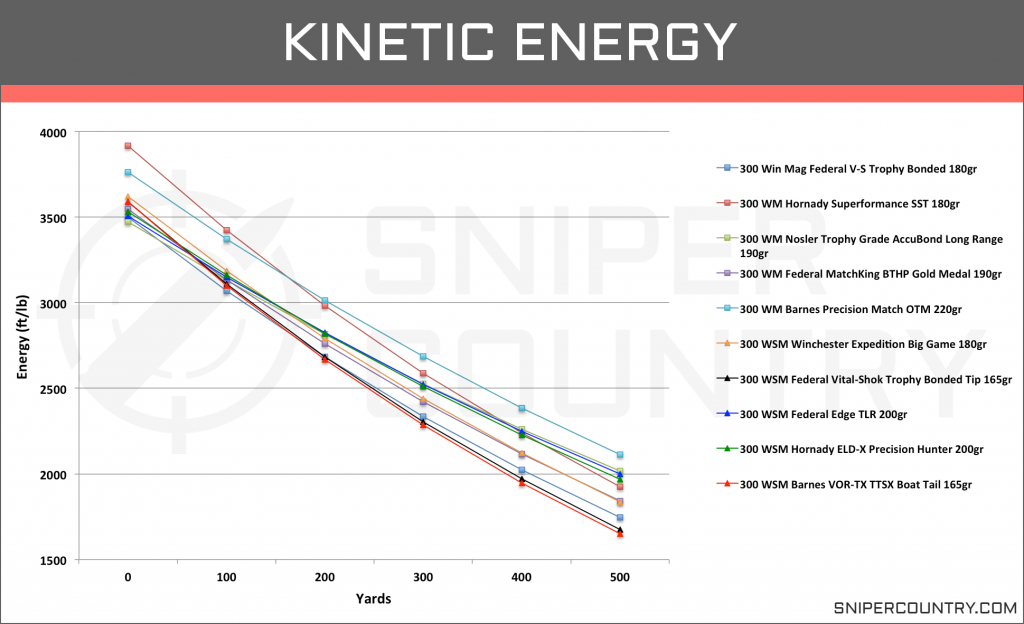

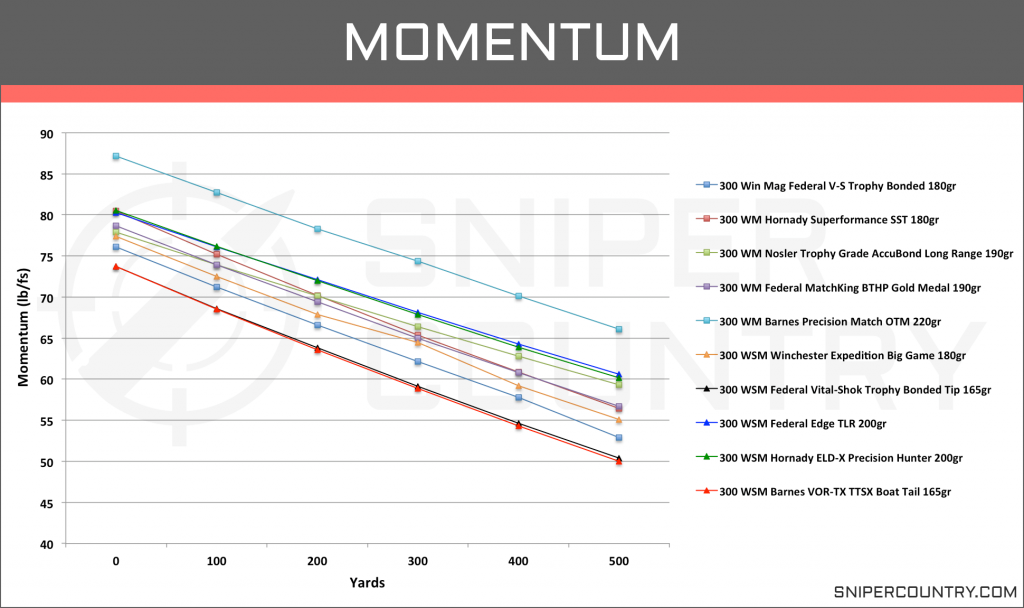

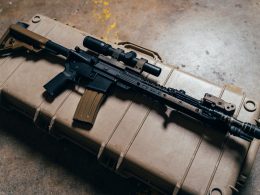
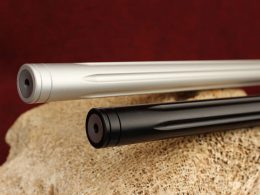
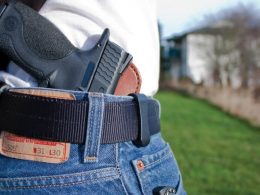

Through off? Say what?
Fixed, thanks!
The differences between the two are somewhat negligible. I got two 325wsm rifles. It is not nearly as popular as the 300. If I burn out the barrels it may be wise for me to rebarrel to 300-which is an easy barrel switch. Great comparison – good depth. For now I’ll shoot my 325wsms in 200 and 220 grain.
Great elk,moose,eland,nyala,bear(even cape buffalo).
In most jurisdictions in Africa, Cape buffalo has a minimum requirement of .375 caliber and 4000 flbs of energy. The .325 or 8mm does not qualify.
awesome right up! thanks a bunch!
Very well written so the average Joe as myself can understand .
Very well researched, very thorough article. Great information.
One important point however is that the average speed of the 300 Win Mag that you show as 2973 fps is about 150 fps short in modern loads. I would have agreed with you if you were using factory loads 20 years ago. Not the more recent loads. In fact the 300 Win Mag is about (if you want to quantify it) 5% more powerful overall than the 300 WSM. It also pushes heavier bullets (200 grains, 220 grains…) about 8% to 10% faster than a 300 WSM. If one doesn’t reload, strictly using factory rounds, there is still a difference in favor of the 300 Win Mag. If one doesn’t reload, most current manufacturers offerings will achieve or exceed their advertised velocities. The Hornady Superformance loads for example do actually chronograph at 3260 fps for 165 grains bullets and 3130 fps for the 180 grains bullet in my rifle. Which has a barrel barely short of 26 inches.
This isn’t to discredit the 300 WSM which is an outstanding cartridge. In most instances the speed differences of medium range bullets are so negligible that the choice between the two has to do with personal preference.
I run Berger 210s in my hand loads for 300 WSM and they are a great shooting round. I’ve got some 230s waiting for me to (some day) build a load up. But I’m much more of an AS (I try to run 6 FPS or lower) and wind-resistance (BCs of .5 or higher) guy than a speed guy, which is why I keep coming back to slower burning but more consistent powders.
Thank you, In the 300wsm crew but appreciate it is a choice. recoil did present a learning curve for me.
I own a 300 win mag and handload 200 grain ELDX for it . I took a 5×5 whitetail with it last November at 362 yards . It put the smack down on him .
Great article, cover all important points. I shoot the 200 eld-x in wsm.
Longer barrel, great accuracy. Hits like Thor’s hammer. Took a big 6×6 bull at 612 yards. Two side steps and feel over.
I do have a muzzle brake to ease the “kick”
Thanks for the good read.
Is there really no ammo available for these two guns that use the same bullets?!? This could have been a great article had you compared “apples to apples”. But where you cannot get the same performance out of one gun using different ammo, how can you draw any real conclusions when you never use the same projectile loaded by the same manufacturer in both guns? You could, in theory even pick & choose the ammo you want for each gun to produce what ever results you wanted to promote. That is not what I believe happened. But what is the point of comparing all different loads? You may as well have used only one gun.
Agreed. I suppose it had to do with available factory cartridges available?
“The .300 Win Mag also has a higher max pressure”
The WSM is 65k and the WM is 64k, so lower max pressure.
i recenly purchased a 300wm,would i be able to use 300wsm with this same rifle
Really?
Your cartridge MUST match the chamber.
There are many different 300 chambers but only one specific cartridge works in any gun.
I own a Belgium Browning with the factory stamp of 300HnH , yet the other side has a newer, different stamp 300 Weatherby.
It CAN NOT use 300HnH.